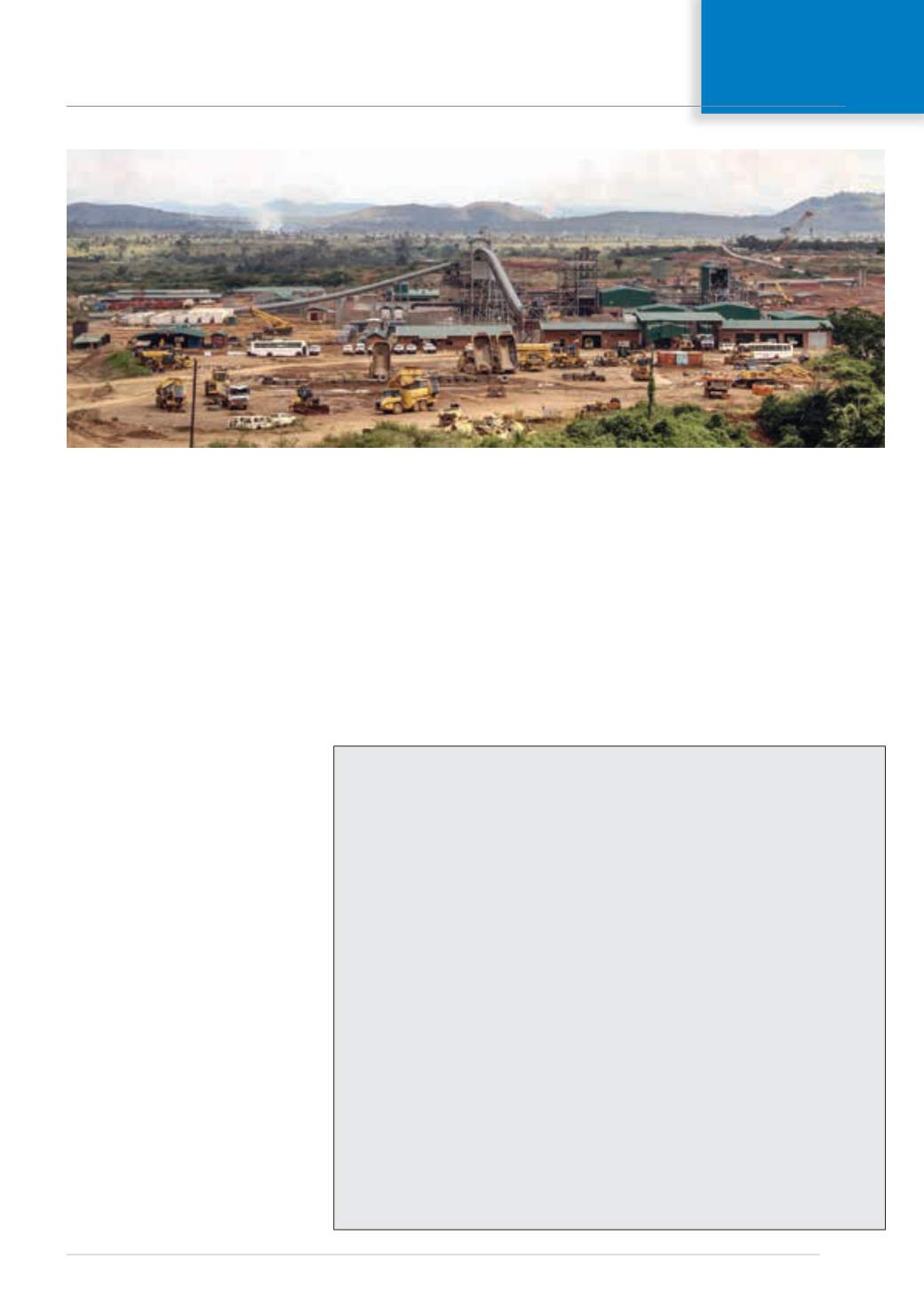

September 2015
MODERN MINING
5
MINING News
In its financial and operating results for the
second quarter of 2015, Canada’s Banro
Corp, which operates the Twangiza and
Namoya gold mines in the DRC, says that
Twangiza continued to outperform expec-
tations, resulting in a 60 % increase in gold
production to 34 325 ounces fromQ2 2014
production of 21 431 ounces.
During the second quarter of 2015,
the plant at Twangiza processed 428 661
tonnes of ore (compared to 340 654
tonnes during the second quarter of 2014
and 428 844 tonnes in the first quarter of
2015), maintaining the first quarter of 2015
achievement of 101 % of design capacity.
Ongoing debottlenecking and incre-
mental process improvements allowed for
throughput levels to be maintained while
increasing the proportion of non-oxide
material to an average of 43 % for the quar-
ter. Ore was processed during the second
quarter of 2015 at an indicated head grade
of 3,01 g/t Au (compared to 2,44 g/t Au
during the second quarter of 2014 and
3,21 g/t Au during the first quarter of 2015)
with a recovery rate of 82,2 % (compared
to 84,3 % during the second quarter of
2014 and 80,7 % in first quarter 2015).
During the second quarter of 2015, the
Namoya mine produced 10 525 ounces
of gold from a total of 330 267 tonnes
of ore, stacked and sprayed on the heap
leach pads, at an indicated head grade of
1,53 g/t Au. Stacking levels at the begin-
ning of the second quarter decreased
substantially from those achieved in March
2015, as a result of the impact of modify-
ing the mine plan to allow for earlier access
to the Kakula reserve pit, as well as the
adverse impact of unseasonably high rains
on the delivery of materials and supplies.
During the second half of June and
early July, Namoya achieved stacking
rates in excess of 5 000 tonnes per day
(tpd) leading to material stacked in July
of 151 026 tonnes. Further improvements
are expected in August and September.
Namoya’s focus is on ore delivery in order
to support the increases in the stacking
rate towards commercial levels as well
as optimising the stacking process with
the agglomerated heap leach in order to
improve percolation and gold extraction.
For the third quarter of 2015, Namoya
is preparing for the delivery of the Cat 777
mining fleet additions. The Namoya
Summit deposit has been cleared for
delineation and is planned to be ready
for production activities during the fourth
quarter of 2015.
The processing plant at the Namoya gold mine in the DRC (photo: Banro).
Banro reports on performance at DRC gold mines
BK11 kimberlite resource estimate updated
Tango Mining, listed on the TSX-V, has com-
pleted an updated NI 43-101 resource for
the past-producing BK11 kimberlite dia-
mond mine in Botswana. The mine is part
of the Orapa/Letlhakane kimberlite district
and the resource is contained in a dia-
mond-bearing, champagne-glass shaped
kimberlite pipe with a surface area of 8,7
hectares (revision based on new geophysi-
cal modelling).
The updated estimate comprises
17,4 Mt of inferred resource containing a
total of 780 820 carats of which approxi-
mately 9,0 Mt averages 6,8 cpht for a total
of 608 000 ct with higher-grade areas being
identified at 9,8 cpht.
BK11 contains good quality white dia-
monds in the top 10 % of global gem
diamond production in terms of value per
carat. The recovery of a 1,5 ct high quality
Type IIa D colour diamond is significant as it
indicates the presence of top quality stones
within the BK11 kimberlite, with the poten-
tial for large +100 ct stones.
Based on the 2015 market, diamond
valuation experts advise a minimum aver-
age price of US$236/ct, a modelled price of
US$260/ct and an upside price of US$285/ct.
The resource is based on the evaluation
of 6 392 m of core drilling and 1 473 m of
large diameter drilling. Sampling and min-
ing produced approximately 19 000 ct that
was valued up until February 2012 and ana-
lysed in terms of size frequency distribution.
Tango has run feasibility studies in
parallel with the resource work and is pre-
paring a NI 43-101 Preliminary Economic
Assessment report. As part of this work,
recently completed rock hardness measure-
ments have enabled autogenous mill sizing
to be conducted. The deposit is considered
as soft in the greater diamond industry and
an autogenous mill retrofit to the existing
plant is being assessed.
Botswana Power Corporation grid power
has been installed to the site boundary and
will be more cost effective than the histori-
cal andmore expensive diesel generators.

















